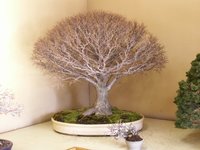O
Ok, I’m learning as I go, and the moss looked unique and attractive. As far as the Zelkova goes, what do you think of this particular tree. The bark is really attractive, I liked the color of the trunk, the broom style pruning looks nice.That tree isn't showable. I have a feeling that pot is its home. Not a big deal, elms can take shallow containers. The moss, however is becoming a problem for the tree in the pot. It should have been removed or reduced substantially a while ago. It can start to shed water from above, channeling it away from the roots. It can also hide rotten roots that need to be addressed.
Moss is not used by more experienced bonsaists for the most part, until it is temporarily put down a couple of months before a show. It is removed after the show is done. It certainly isn't allowed to mound up like this. If this tree were in a show, judges would probably deduct points for it. It doesn't look natural and hints at a bit of neglect.








